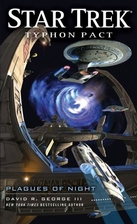The whole thing is essentially an adaptation of the film version of Goldfinger, though. Just like how in Goldfinger, Bond investigates a gold-smuggling pipeline and ends up discovering a plot by a deranged capitalist to blow up the largest supply of gold, here Bond investigates a microchip-smuggling pipeline and ends up discovering a plot by a deranged capitalist to blow up the largest supplier of microchips. There are lots of parallels: like Goldfinger, Christopher Walken's Zorin cheats at games, has Bond as a houseguest, builds scale models of things (in fact, two different ones), and convenes people to look at them. It was that latter scene that convinced me this was a total rip-off, as just as in Goldfinger, one of the guys Zorin brings in wants no part of it, and so Zorin has him melodramatically killed off. The microchip cabal is pretty irrelevant, though; Bond never even discovers Zorin's co-conspirators exist, so they presumably get off scot-free.
 |
| I would be down with more Bond villains cruising around in blimps. |
This was Roger Moore's last film as James Bond, but even if you didn't know that (I checked after it was over), the whole thing seems very tired, a marked contrast to the energetic For Your Eyes Only. The love scenes are as nonsensical as ever, and the fights completely lack any kind of zip or energy. Like most Roger Moore films, this features multiple doofy car chases, but without the sublimity that made the opening one from For Your Eyes Only so good. I couldn't put my finger on it, but the comedy chase that opens this one (where Bond's car keeps getting bits cut off) is stupid whereas the junky car chase in For Your Eyes Only is genius. And then there's this weird car chase where Bond steals a firetruck and comedy American policemen-- a strange staple of the Moore films-- come after him in scenes that belong in The Blues Brothers, except that they're not funny.
 |
| Britain's finest. |
The thing that really sinks Roger Moore's Bond in this film isn't that he's too old to do the action or love scenes, it's that he seems to have lost all his charm. When Bond infiltrates the enemy as a socialite, he should be suave and charming, and make his enemies like him. Instead he just comes across as a smug asshole, and you have to wonder why anyone puts up with him, or why he expects this plan to work.
Other Notes:
- Patrick Macnee appears as a fellow MI6 agent of Bond's. Macnee starred in ITV spy programme The Avengers (1961-69) at the same time Roger Moore starred in ITV spy programme The Saint (1962-69). There's some funny interplay between Moore and Macnee, but Macnee is completely superfluous, so you know that he's there just to be killed off to prove the situation is serious. And indeed, he is.
- As you might imagine for a film about microchips, there are a lot of scenes where computers do something supposedly amazing that looks hilarious in retrospect.
- I didn't really discuss the "Bond girls" very much, but they have very little impact. One feels the villainous May Day could have been excellent in a better film, but here she has to say lines like "What a view..." to set up Christopher Walken saying "...to a kill." She has two minions of her own, who end up contributing so little to the movie I have no idea why they're there. Bond also meets up with a Soviet agent he apparently slept with in the past, and he sleeps with her again, but she seems to get more excited over Tchaikovsky than his prowess.
- I think this is the first movie with Robert Brown as M that I've seen. I don't think he's steely enough for the character. Frederick Gray, Minster of Defense, is here yet again. I never really get why Bond's briefing scenes require three different fussy old men (Gray, M, and Q) during the Roger Moore era.
- The visuals during the title song are hilariously awful, including in part what I think is supposed to be sexy skiing.
- The best part of the movie is during the cold open, when Bond snowboards to "California Girls." Sublime.
- James Bond is revealed to cook a mean quiche.
Film Rankings (So Far):
- Casino Royale
- Dr. No
- From Russia with Love
- For Your Eyes Only
- Goldfinger
- Moonraker
- A View to a Kill
- Live and Let Die
- Diamonds Are Forever




























